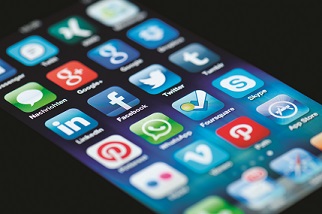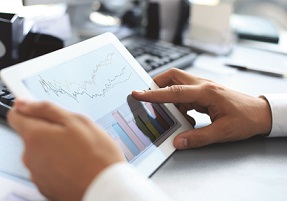
 Wimbledon 2013 was one of the most talked-about tennis tournaments in history. Defending champs were eliminated early and for the first time ever, a Briton brought home a men’s singles title. The “Bryan Slam” doubles team of American twins Bob and Mike Bryan chest-bumped their way to a third Wimbledon title, becoming the first to hold all four Grand Slams and the Olympic Gold simultaneously. Spectators packed Centre Court while on social media, 69 million Facebook users and 850,000 Twitter users followed along.
Wimbledon 2013 was one of the most talked-about tennis tournaments in history. Defending champs were eliminated early and for the first time ever, a Briton brought home a men’s singles title. The “Bryan Slam” doubles team of American twins Bob and Mike Bryan chest-bumped their way to a third Wimbledon title, becoming the first to hold all four Grand Slams and the Olympic Gold simultaneously. Spectators packed Centre Court while on social media, 69 million Facebook users and 850,000 Twitter users followed along.
The same year, WrestleMania 29 became the highest-grossing live event ever held at MetLife Stadium in Rutherford, New Jersey. Eighty thousand fans from all 50 states and 34 countries experienced what was also the most socially active one-night event in WWE’s history with 1.55 million social media mentions.
Both events generated widespread social media engagement and both were Shorty Awards® nominees for Best Use of Social Media for Sports that year. (WrestleMania 29 took the Shorty). All nominees had social media strategies that drove their marketing, promotions and fan engagement success.
You too can devise a strategy to harness the power of social media for your event, no matter what size, level or sport, by following the some of the same principles used by the pros. Frame your process around defining your mission, developing your engagement strategy, selecting your tactics and using analytics to measure results.
Define your mission and goals
The mission for your social media strategy should focus on developing a broad, loyal and engaged social media following as a means to drive value for key event stakeholders.
Your following is measured in the number of social media users that follow and interact with your event’s social media accounts. Engagement among your following is then measured in the number and rate of your social media follower interactions (comments, mentions, retweets), over time.
Your event’s key stakeholders are the foundation of your social media following. Engage with competing teams/individuals, spectators, sponsors, governing bodies, host cities, facility owners, event vendors and the media. If you successfully engage them, your social media reach will begin to extend to their followers, creating a ripple effect.
The reach of social media transcends geographic boundaries; think globally to grow your following. National and international events in your sport present opportunities to seek out and engage new followers. News and sports media outlets that cover your sport online are also targets for followers that may be interested in your event.
Engagement strategy: Content is Still King
Successful social media engagement depends on your ability to share timely content that is relevant to stakeholders’ interests. Don’t think of your social media platform as an e-billboard for your event. Rather, seek to engage by adding to the conversations your stakeholders are having on social media. A quick review of recent content shared by and among your key stakeholders and their followers can help you identify general themes.
Well before your event, start building engagement by sharing content. Pre-event is also a great time to partner with governing bodies, host cities and facilities vendors to support event co-promotion through social media. Your partners, venues and vendors can bring added social media reach when they use your event hashtag and repost your content.
As your event approaches, build excitement by sharing countdowns and updates from run-up events such as exhibition games, interviews, host city and fan-related activities. Gamification strategies and follower awards can be used to build pre-event engagement and following.
Live action during the event provides some of the best content for social media activity and engagement. Images, video, real-time results and standings notifications and interview sound bites can be shared across platforms. Your goal is to make the live action accessible to a global audience.
Track, Measure and Analyze
Once a social media strategy is launched, collecting and analyzing key performance data is the next, vital step in the social media marketing process. Before you launch, you’ll want to decide what metrics you’ll track, establish the means to collect the data and set the baselines for key metrics to measure against changes in your key performance areas over time.
Most social media platforms offer free analytics reporting. Start with what’s offered there, benchmark the data points and analyze changes over time. If patterns emerge, like certain days, times of day or types of content consistently producing better engagement results, use that intelligence to inform future social media strategies.
 Applying Resources
Applying Resources
Building a social media following and sustaining it in a meaningful way will require resources, but that doesn’t always mean a big-dollar budget. Still, don’t be afraid to explore the world of paid social media marketing and advertising, as a boost to your organic social media engagement efforts. For as little as a few hundred dollars, you can generate hundreds of thousands of new impressions through a Twitter ad campaign; Facebook, the world’s most popular network, also provides what most marketing experts agree is a very cost-effective advertising program.
On a tactical level, a successful social media campaign will require personnel with expertise and access to social media user accounts, to coordinate pre-event efforts (branding development, preparation of baseline analytics, content development and planning), to stay on top of on-site coverage and to coordinate post-event follow up and activity analysis.
Your tactical team can be scalable to your event and your budget size, but a team leader should always be identified, to serve as the key point of contact for coordination of the overall strategy.
Tactical Approaches
With a mission in mind, a defined audience of potential followers to engage and relevant content to share, you can now start setting up the social media tools and tactics to get you where you want to go.
Establish your event’s social media “brand” and identity by creating a unique event hashtag and graphics to serve as the “visual brand” for your event. Don’t forget a short, compelling statement to serve as your event’s user account bio, an important yet sometimes overlooked element of social media.
Once your branding is in place, you’ll want to determine the platforms you’ll use. It’s important to post across multiple platforms, a task handled most efficiently with a social media management and dashboard tool like HootSuite or Everypost. Put thought into your audience demographics when choosing appropriate platforms for your event.
Following is a review of some of the top three most commonly used social media platforms for events and tips on how they can be best leveraged in your sports event promotions:
Twitter: a platform useful for instant dialog and broad reach
Before: create a Twitter account for your event and apply your branding; create a unique, official hashtag; tweet and mention the hashtag daily and share relevant content and media coverage regularly.
During: assign dedicated staff for live-monitoring of the Twitter feed and hashtag; promote the hashtag in prominent visuals at the event site; share updates, news, key developments and general announcements; respond in real time to mentions and retweets; post at least one image daily.
After: share photos, videos and media coverage; monitor impact using analytics.
Facebook: a platform useful for its sheer numbers and ease of use:
Before: create your Facebook event and apply your branding; post content three or four times weekly, with images wherever possible.
During: share photos and status updates at least once daily; encourage followers to share experiences, check-in to event locations and “tag” themselves in images shared.
After: post a “thank you” status update; evaluate results with Facebook Insights; organize photos into Facebook albums; encourage followers to continue to “tag” themselves in photos.
Instagram: a platform for visual appeal that is easily integrated with Facebook and Twitter:
Before: create an account and develop an account profile for your event, applying your branding; use your hashtag in posts, along with the URL for your event; promote the Instagram account from your other social media profiles.
During: assign dedicated staff for capturing and posting two to three images daily from the live action; promote the Instagram account in prominent visuals at the event site; keep the captions short and compelling and include the hashtag and event URL.
After: download all posted photos and archive them; add to your Facebook album

